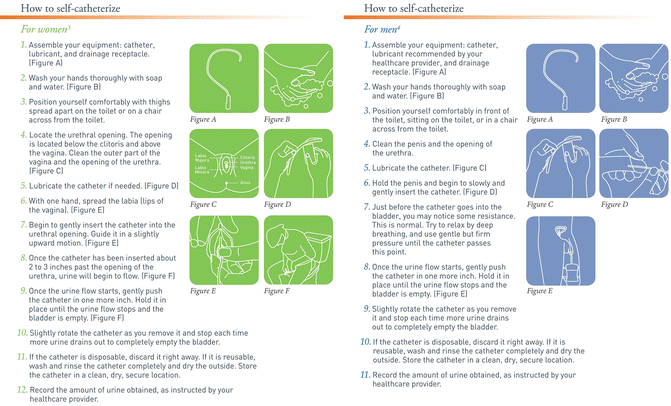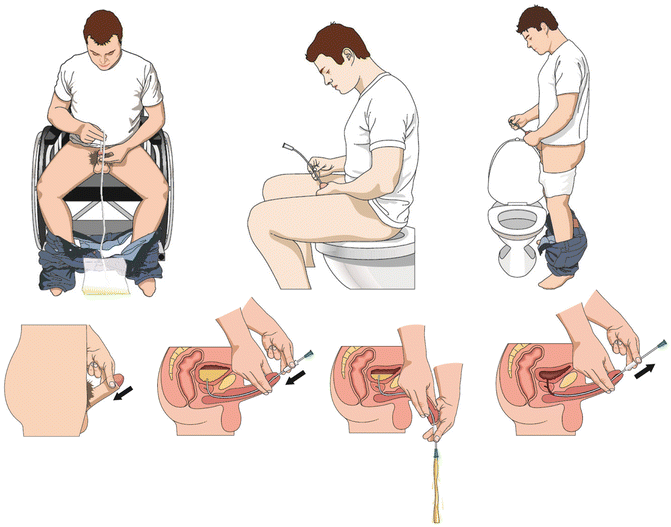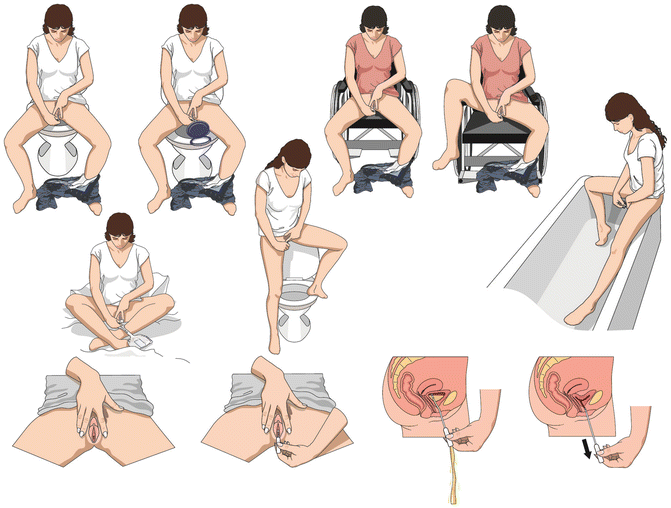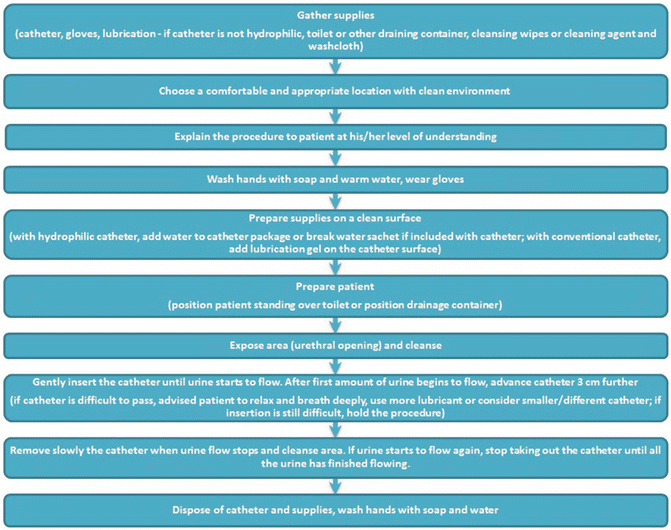and Mikolaj Przydacz1
(1)
Department of Urology, Jewish General Hospital, McGill University, Montreal, QC, Canada
Keywords
Intermittent catheterizationClean intermittent catheterizationYouTubeToileting assistanceBladder trainingTimed voidingHabit retrainingPrompted voidingPelvic floor muscle therapyDietary modificationsFluid intakeWeight controlConstipationNicotineIntroduction
Patient education is an important principle during consultation with individuals suffering from neurogenic lower urinary tract dysfunction. It empowers patients to engage and participate in their own treatment. Active participation on the part of a willing patient is of utmost importance for individual motivation and long-term adherence. As a general rule, patient education should be tailored to the patient’s level of understanding, and a caregiver or family member willing to assist in the interventions should be involved in the teaching process.
Intermittent Catheterization
Intermittent catheterization (IC) is considered the method of choice for bladder emptying when neurological disorder makes normal voiding impossible or incomplete [1]. The short- and long-term positive outcomes have been demonstrated. However, there is no one best technique, as the chosen method depends greatly on patient’s individual anatomic, social, and economic possibilities. Regrettably, the literature to date does not clarify the definition of each specific technique. As a result, practice differs, even though the same name may be used. The European Association of Urology Nurses (EAUN) proposed standardizing the terminology as follows [2]:
Sterile technique —all the material is sterile and catheterization is performed in sterile settings; complete sterile technique is only used in operating rooms and in diagnostic situations
Aseptic technique —involves sterile catheter, disinfection of the genitals, sterile gloves (with sterile tweezers, if required) and sterile lubricant (if the catheter is not pre-lubricated)
No-touch technique —an aseptic technique with a ready-to-use catheter (these catheters lubricate themselves as they are introduced into the urethra by a prelubricated outlet on the bag); a pull-in aid or special packages are used to touch the catheter; this technique should be considered particularly when toilet facilities are not readily available (e.g., during sports activities or travel)
Clean technique (clean intermittent catheterization) used by patients or caretakers in the home setting with sterile (single-use) or reusable catheter and septic or no antiseptic solution for cleaning the hands and perineum. In clean self-IC, the catheter can be touched without gloves
A well-trained and experienced clinician, usually a specialized nurse, has an important role in training the patient for successful self-catheterization and long-term adherence with management, as there are multiple barriers to clean IC (Table 17.1) [3–5]. The pencil and paper test can be used to predict the ability of neurological patients to practice clean self-IC [6]. This test mimics the ability to open the packaging and handle a catheter, as well as cognitive strategies required to accomplish all clean self-IC maneuvers; it typically requires less than few minutes to complete. Sheets of paper and a pencil 20 cm long with a horizontal diameter of about 0.5 cm are the tools needed to perform the test. Each item of the test is quantified and simply graded as 0—impossible, 1—incomplete, 3—full but difficult, and 5—possible and easy. The maximal score is 15. A test score of less than 10/15 suggests that clean self-IC should not be proposed in a patient with neurological disease. In contrast, a test score of more than 10/15 suggests a high probability of success in learning and practicing clean self-IC. Table 17.2 lists the required gestures that mimic the usual maneuvers used during self-IC , along with the developed scoring system [6].
Table 17.1
Possible barriers of clean intermittent catheterization and possible solutions to improve adherence
Possible barriers | Possible solutions |
|---|---|
Patient-related factors (internal) | |
Physical disabilities • Positioning • Mobility • Dexterity • Coordination • Balance • Visual impairment • Perception • Cognition Psychological concerns • Fear and anxiety • Social stigma • Depression • Decreased self-confidence and self-esteem • Embarrassment | • Individualized and tailored instructions with a clinician trained in teaching IC (some patients may require a few sessions to feel confident with the technique) • Documentation materials about IC (e.g., booklet, pamphlet, instruction movie) • Providing an overview of anatomy of the urinary tract and reported bladder dysfunction • Choosing the appropriate catheter (patient may need to try several catheters before finding the preferred type) • Use of catheter appliances to help locate the urethra – Catheter clips – Penis holders – Thigh abductors – Leg/knee spreaders – Mirrors – Labia spreaders |
Environmental factors (external) | |
• Limited access to public toilets and their inadequate facilities (e.g., for placing catheter products and accessories or transferring from a wheelchair onto the toilet; inadequate cleanliness and washing) • Limited access to well-trained healthcare providers • Low teaching quality and inappropriate training locations • Limited access to the right type of catheter and lack of knowledge of the products available on the market • Financial constraints • Inadequate follow-up monitoring | • Access to locked disabled toilets and measures that help locate toilet facilities (e.g., maps, smartphone apps) • Proper education and standardized training of healthcare providers (including district nurses) • Adequate training locations and time for teaching of patients • Involving caregivers/partners into training sessions • Regular follow-up monitoring • Financial support to patients suffering from neurogenic lower urinary tract dysfunction • Efficient catheter delivery system in the community including home delivery systems • Proper communication between primary and secondary/tertiary care |
Table 17.2
Requested gestures of the pencil and paper test with scoring system
Sex | Gestures | Points | |||
|---|---|---|---|---|---|
Impossible | Incomplete | Full but difficult | Full and easy | ||
Males | Pencil clasped with index + thumb, then positioned in ear canal (dominant hand) | 0 | 1 | 3 | 5 |
Pencil clasped with palm + fingers, then kept vertical (non-dominant hand) | 0 | 1 | 3 | 5 | |
Paper folded, torn + given | 0 | 1 | 3 | 5 | |
Females | Pencil clasped with index + thumb, then positioned in ear canal (dominant hand) | 0 | 1 | 3 | 5 |
Pencil positioned horizontally between thighs | 0 | 0.5 | 1 | 2 | |
Pencil laid on thumb + index finger moved apart | 0 | 0 | 0.5 | 1 | |
Pencil laid + kept up on chair between thighs | 0 | 0.5 | 1 | 2 | |
Paper folded, torn + given | 0 | 1 | 3 | 5 | |
Clinicians and patients sometimes fail to consider self-IC as an option in the elderly because of a perception that it will be unmanageable or poorly tolerated. Nonetheless, recent data indicate that a high proportion of older patients can successfully be taught self-IC, thus it can be offered irrespective of age [7].
Even though the clinician’s time and resources in daily clinical practice are limited, patients should be carefully educated on how to perform self-IC, and this learning process should be the standard of care. Patient education needs to have a structured procedure in order to evaluate the ability to understand, accept, and perform self-IC [8]. Studies have shown that clean self-IC can be taught to most patients in a short time, even within a few minutes [9]. Clinicians should also be aware that their expectations are often too high when it comes to training patients in IC (e.g., see flexibility in frequency of catheterization, Table 17.3) [10, 11]. The no-touch technique may be preferred over the clean technique but available data are insufficient to make reliable recommendations (see Chap. 8). The clean technique is also an optimal choice in the home setting because individuals are there exposed to bacterial organisms that do not routinely cause infections.
Table 17.3
Patients may be advised to adjust the frequency of their self-catheterization based on the drained urine volume
Urine volume (mL) | Catheterization frequency |
|---|---|
>400 | 4–6 times a day |
400–300 | 3 times a day |
300–200 | Twice a day |
200–100 | Daily |
At the beginning, the patient should be prepared verbally for the procedure [2]. It is beneficial to support initial teaching with documentation about intermittent catheterization (e.g., booklet, pamphlet, instruction movie) (Fig. 17.1). A brief explanation of the pathophysiology of bladder dysfunction is also encouraged. Providing an overview of anatomy with pictures or the use of an anatomic model of the genitals/perineum can be very helpful. Caregivers should be involved in the learning process. The clinician should also evaluate the patient’s capability of performing self-IC , motivation to continue long-term catheterization, and awareness of the difficulties and possible complications associated with catheterization. If the referring physician has already recommended the optimal catheter type/material as well as catheterization technique and frequency (4 and 6 catheterizations per day are advocated in order to limit bladder distension and the total volume should not exceed 400–500 mL), the patient should be counselled on these issues again [12, 13].


Fig. 17.1
Example of a patient pamphlet provided for the initial instruction (with permission from courtesy of Allergan, Parsippany NJ, USA)
The patient should then be informed about necessary supplies (catheter; lubrication, if catheter is not hydrophilic; toilet or other draining container; cleansing wipes or cleaning agent; and washcloth and gloves, if applicable) and possible locations where (and positions in which) IC can be performed (home, work, school, bed, bathroom, toilet, wheelchair) (Figs. 17.2 and 17.3). After that, the patient should be carefully instructed about hand washing (hands should be washed or aseptic towels should be used both before and after catheterization), glove wearing (if applicable), cleansing of the genitals, and insertion procedure. If the clean technique has been chosen, the patient should be carefully informed to wash hands right before the catheter insertion and not to touch the end of the catheter. It has to be stressed that the catheter must be introduced in a minimally infecting and atraumatic way (with no force). The first attempt can be done either by the healthcare professional or by the patient him/herself, and the patient should be informed not to remove the catheter until the bladder is completely empty. Females may be advised to use a mirror when performing self-IC, and should be instructed on where to place the catheter by showing how to separate the labia and identify the urethral opening. It is recommended that the patient repeat the insertion him or herself if the clinician has performed the first attempt. A minimum interval of 4 h is recommended between two catheterizations [8]. After performing the insertion, the clinician should assess whether the patient feels comfortable with the procedure and, if not, a change of catheter type, material, or technique should be considered. The clinician should also try to improve the patient’s self-confidence. Figure 17.4 presents the general steps of teaching the patient when the clinician performs the initial catheterization [14–16].




Fig. 17.2
Patient positioning during self-intermittent catheterization (male) (with permission from courtesy of Wellspect HealthCare and LoFric Academy, Mölndal, Sweden)

Fig. 17.3
Patient positioning during self-intermittent catheterization (female) (with permission from courtesy of Wellspect HealthCare and LoFric Academy, Mölndal, Sweden)

Fig. 17.4
General steps of patient teaching when the initial catheterization is performed by the clinician
Individuals who choose intermittent catheterization with reusable catheters need proper education with regard to catheter care . Washing the catheter after every use is recommended [17]. Rinsing and allowing catheters to air-dry between each use has been demonstrated as an effective technique to keep the bacteria on catheters at a low count [18]. Catheters should be cleaned with mild soap and water or antiseptic solution (peroxide and povidone-iodine), air-dried, and placed in a paper bag until ready to reuse [17, 19]. To minimize encrustations, patients should be encouraged to forcefully rinse the catheter lumen with tap water, making sure to remove all lubricant, if used [20]. If recurrent urinary tract infections occur, catheter sterilization by boiling it or heating it in a microwave oven, as well as use of single-use catheters, may be considered [21]. Nevertheless, clinicians should bear in mind that these techniques of sterilization may be insufficient to eradicate all microorganisms, including Pseudomonas aeruginosa or Staphylococcus aureus [22]. Patients should be warned not to reuse the catheter if it looks worn, brittle, or cracked.
A wide variety of educational materials are available to patients in this regard and patients should be informed of reliable sources. These include but are not limited to:
patients.uroweb.org—educational center developed by the European Association of Urology (EAU)
urologyhealth.org—educational center developed by the Urology Care Foundation supported by the American Urological Association (AUA)
cua.org/en/patient—patient information center developed by the Canadian Urological Association (CUA)
continenceproductadvisor.org—educational website created by the International Consultation on Incontinence (ICI) and the International Continence Society (ICS)
clinicalcenter.nih.gov—patient education resource site created by the Clinical Center of the National Institutes of Health, United States
medlineplus.gov—patient medical encyclopedia created by the National Library of Medicine and National Institutes of Health, United States
aboutkidshealth.ca—educational website developed by the Hospital for Sick Children in Toronto, Canada
experiencejournal.com/journals/self-cathing—an online resource for patients and families who are recommended to initiate IC developed by the Boston Children’s Hospital in Boston, United States
catheter manufacturers and distributors (e.g., LoFric, Coloplast, Bard, Cook, Hollister, Convatec)
A recently published study has evaluated the educational content of YouTube videos relating to neurogenic bladder and intermittent catheterization [23]. Analysis indicated a poor, misleading, or irrelevant overall quality of the information, with some videos giving advice that is contradictory to well-developed guidelines for IC. The YouTube search algorithm did not prominently rank videos that the authors deemed of good quality, which suggests that users would be less likely to access those. The quality of information in videos with healthcare narrators was not consistently higher than in those featuring patient or merchant narrators. About half of the videos featuring catheter use also contained some kind of advertisement. Therefore, YouTube materials should be recommended only with caution, and clinicians should be aware of the dubious quality and veracity of the YouTube information. While Web-based interventions and social media are becoming common, clinicians should inform patients about concerns regarding the quality of such information.
Stay updated, free articles. Join our Telegram channel

Full access? Get Clinical Tree








